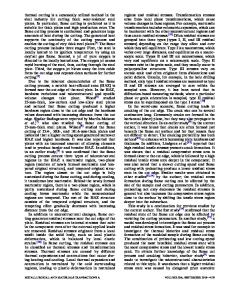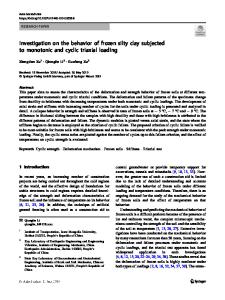The Residual Stress Relaxation Behavior of Weldments During Cyclic Loading
- PDF / 1,085,135 Bytes
- 10 Pages / 593.972 x 792 pts Page_size
- 61 Downloads / 399 Views
NTRODUCTION
RESIDUAL stresses introduced during the welding process can have a significant influence on the fatigue strength of welded components.[1–7] There are many ways to reduce potentially harmful residual stress to prolong service life, such as annealing,[8,9] pre-stretching,[6] and shakedown.[10–12] For the purpose of accurate assessment of fatigue lifetime, not only the magnitude of the residual stresses, but also their stability factors and evolution during service are of great importance.[13] Numerous researchers have reported significant relaxation during cyclic loading,[7,14–24] with redistribution of residual stresses occurring after the first loading cycle followed by minimal further relaxation during subsequent cycles.[8,25–27] By applying the principles of continuum mechanics and fundamental physics, the evolution and redistribution of residual stresses such as those caused by welding can be explained.[28] However, an understanding of the complicated interactions that result between the applied stresses and those that develop when a part is welded requires knowledge of a full 3D residual stress profile and detailed material properties, which is rarely possible in practice. As an alternative, some empirical relaxation models[25,27,29–31] based on experimental data obtained from studies of a number of different combinations of material and loading have been proposed. For example, Valluri ZHONGYUAN QIAN, formerly Ph.D. Candidate with the Iowa State University, Ames, IA 50011, is now Materials Consultant with the Invetech Inc., Houston, TX. Contact e-mail: [email protected] SCOTT CHUMBLEY, Professor, and TUGCE KARAKULAK, Ph.D. Candidate, are with the Iowa State University. ERIC JOHNSON, Staff Engineer, is with the John Deere Company, Moline, IL. Manuscript submitted May 2, 2012. Article published online March 15, 2013 METALLURGICAL AND MATERIALS TRANSACTIONS A
et al.[32] suggested that residual stress relaxation is a phenomenon similar to creep. Several investigations[8,27,33] have shown that the amount of relaxation is a function of applied cyclic stress. However, one common deficiency of the existing models is that they are unable to separate variables related to the material from those related to the applied stresses. Perhaps even more importantly, they are incapable of accounting for the high amount of relaxation that occurs during the first cycle. These two aspects were emphasized in the current study. In general, the proposed mechanisms for residual stress relaxation due to cyclic loading can be divided into three regimes according to the applied cyclic stress amplitudes: (1) below the endurance limit, (2) above the macroscopic yield strength, and (3) in between these two extremes.[13] In the current study, cyclic amplitudes were applied in all three regimes noted above on different weld specimens, including low carbon steel AISI 1008, low alloy steel ASTM A572 and AISI 4142. These steels were selected for study because of their wide use in engineering applications such as structural components, heavy cons
Data Loading...











